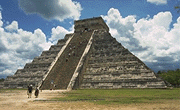

Unit 13

English 203:
Literature of the NonWestern World
 |

Unit 13 |

English 203: Literature of the NonWestern World |
| Introduction | .Explication | Questions | Review |
Introduction:
Reading: 1728-59,
2614-18:
Native America, 1728-35
Florentine Codex, 1736-39
Cantares Mexicanos, 1739-42
Popol Vuh, 1742-59
Navajo Night Chant, 2614-18
This final lesson is devoted the literature written by Native Americans. The Navajo Night Chant, is the only contemporary piece in our text. The major piece in this lesson is the Mayan Popol Vuh. The section we have offers a fairly familiar creation story. The Navajo, e.g., also have stories about the twins who slay monsters & bring order to the world.
This material is difficult for us, not only because we are reading it for the first time, but because the matrix of culture in which it was created & for which it speaks is either irrecoverably lost or exceedingly difficult to enter. Like the monuments of Egypt, you can visit the gorgeous architecture of Mayan civilization in southern Mexico & Guatemala (Chichen Itza, Palenque, Uxmal, Tikal, Monte Alban) & see some of the art in one of the world's great museums, The Anthropological Museum in Mexico City. In Peru you can visit Machu Picchu & see the marvelous Incan walls there & in other places in the Andes. But this great physical culture is not surrounded by an emotionally involving literary culture.
Of course there are millions of descendents of the Mayans & Incas in southern Mexico, Guatemala, & Peru, but their high culture was entirely destroyed by the Spanish. When you visit these places you may be shocked at how unassimilated Native American Indians are in Mexican or Peruvian society, far more so than Navajos in the American Southwest. What remains of Native American folk culture throughout the Americas is at once fairly easy to "drop in on" by visiting Taos, Acoma, Gallup, the Indian Market Day in Santa Fe, Chaco Canyon, or similar places. Buying a piece of turquoise jewelry is easy. (By the way, the gods do not see you, if you are not wearing turquoise.) "Buying into" Native American culture is more difficult, as we will find in this lesson.
Because Mayan monuments are popular travel destinations, there are many good websites devoted to Mayan culture. Here are a couple:
| Mysteries
of the Maya
Pre-Columbian Cultures |
Our text says that
"native American literature my be regarded as essentially technological,
or functional, rather than aesthetic. For the individual its function
is medicinal" (1732). This is somewhat misleading, unless you understand
that the kind of "medicine" that the editor has in mind is comparable to
the "medicinal" lifestyle of Daoism & not like taking an aspirin.
In both Daoism & Native American outlooks, the physical world (including
our physical health) is caused or produced by spiritual powers & ritual
events. It is most important for you to understand that this is not
a moral outlook in which one's motives & intentions are all important.
This is why the editor chose the otherwise strange metaphor of technology;
because he meant to imply that the Native American outlook was not comparable
to Christianity where it is sufficient to love God & your neighbor
& not be overly concerned about details of behavior that have no moral
significance. In the Native American outlook, the world is a dangerous
place. You can lose your health, your good fortune, & your life
by accident. It is not sufficient to pray & hope that God will
look out for you. You must know the dangers & avoid them in order
to successfully live a long & happy life.
 Frank Mitchell |
A very
interesting account of the Native American outlook is offered by Frank
Mitchell, a Navajo Blessingway Singer. He explains that when someone
falls ill it is always because of some spiritual event. Very likely,
someone performed witchery, or gave you the evil eye, or otherwise made
you ill. Or you may have inadvertently violated some taboo, such
as touching a tree that has been struck by lightning. Your family
will most likely employ a Crystal Gazer to make a diagnosis. This
is a kind of shaman who is gifted as well as trained to discern what the
rest of us overlook -- something out of place or something that doesn't
fit in the pattern of "walking in beauty" (cf. the Dao). Once
you know what the problem is likely to be, you can then have the appropriate
ceremony conducted to alleviate the problem & return you to the Blessingway
path of health & happiness.
|
|
Frank Mitchell's autobiography is, unfortunately, a little obscure. Black Elk's autobiography is justly famous. He was a Lakota (Sioux) shaman whose story will very much remind you of Achebe's Things Fall Apart, except that it takes place in South Dakota. |
 . .
Black Elk |
Click on the next section:
| Explication |